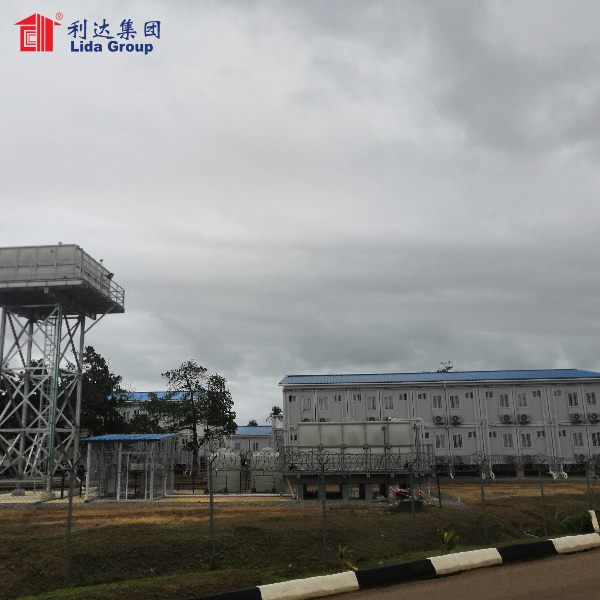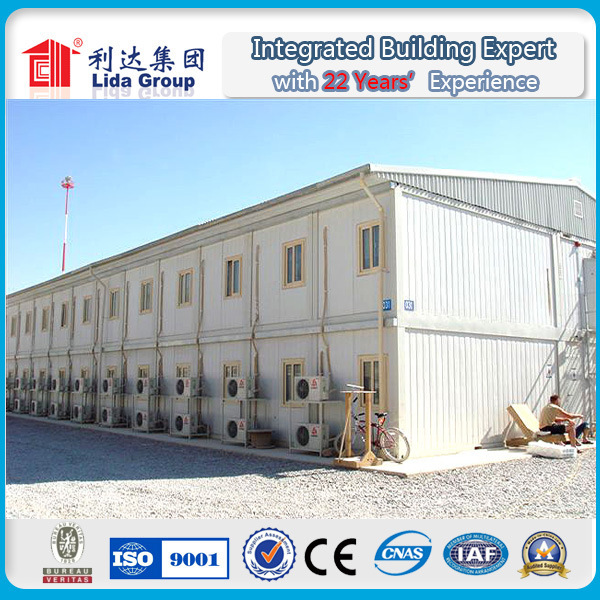Introduction
In the mining industry, the need for efficient, durable, and cost-effective housing solutions has never been more critical. As mining operations often take place in remote locations, traditional construction methods can be impractical, time-consuming, and costly. Lida Group‘s low-cost modular prefab flat pack container houses offer a viable alternative, designed specifically to meet the unique demands of mining camps. This article explores the features, benefits, applications, and future potential of these innovative structures in mining environments.
Understanding Modular Prefab Flat Pack Container Houses
What Are Modular Prefab Flat Pack Container Houses?
Modular prefab flat pack container houses are pre-manufactured structures made from shipping containers. They are designed to be easily transported, assembled, and disassembled, providing a flexible housing solution. The flat pack design allows for efficient shipping and storage, making it ideal for use in remote mining sites.
The Emergence of Container Houses in Mining
The adoption of container houses in the mining sector has grown due to several factors:
- Rapid Deployment: The speed of assembly and disassembly makes them ideal for temporary or semi-permanent housing.
- Cost Efficiency: Lower materials and labor costs make container houses an attractive option for mining companies.
- Sustainability: By repurposing shipping containers, these structures promote environmental sustainability.
Key Features of Lida Group’s Container Houses
1. Robust Construction
Lida Group’s container houses are built to withstand the harsh conditions often found in mining areas:
- Durable Materials: Constructed from high-quality steel, these houses are resistant to extreme weather, corrosion, and physical impact.
- Structural Integrity: The design ensures that the houses can support additional loads, making them suitable for various applications.
2. Customizable Interiors
Flexibility is a hallmark of Lida Group’s container houses:
- Tailored Layouts: Interiors can be customized to include bedrooms, kitchens, bathrooms, and common areas to meet the needs of workers.
- Modular Design: Units can be combined to create larger living spaces or communal areas, enhancing the living experience.
3. Energy Efficiency
Energy efficiency is a critical consideration in mining camps:
- Insulation Options: Advanced insulation materials keep the interior comfortable, reducing heating and cooling costs.
- Renewable Energy Integration: Options for solar panels and energy-efficient appliances further minimize energy consumption.
4. Mobility and Flexibility
The modular nature of these houses provides significant benefits:
- Easy Transportation: They can be easily relocated as mining sites change or expand, making them ideal for transient operations.
- Scalability: Additional units can be added as the workforce grows or as operational needs change.
Benefits of Lida Group Container Houses for Mining Camps
1. Cost-Effective Housing Solutions
One of the primary advantages of Lida Group’s container houses is their affordability:
- Lower Construction Costs: The use of repurposed materials and efficient manufacturing processes significantly reduces costs.
- Reduced Maintenance Expenses: Durable materials lead to lower upkeep costs over time.
2. Quick Setup and Operational Readiness
Speed is of the essence in mining operations:
- Rapid Assembly: These container houses can be set up quickly, allowing companies to deploy housing solutions in a fraction of the time required for traditional construction.
- Minimal Site Preparation: The need for extensive groundwork is reduced, enabling quicker project initiation.
3. Enhanced Worker Comfort and Safety
Providing comfortable living conditions is essential for worker productivity and morale:
- Modern Amenities: Lida Group’s designs can include modern amenities, such as air conditioning, hot water, and kitchen facilities, improving the quality of life for workers.
- Safety Features: The robust construction provides a safe living environment, essential in remote and potentially hazardous mining locations.
4. Environmental Considerations
Sustainability is a growing concern in the mining industry:
- Eco-Friendly Practices: The use of recycled materials and energy-efficient designs aligns with environmental regulations and corporate sustainability goals.
- Waste Reduction: Integrated waste management systems can help minimize the environmental impact of mining operations.
Applications of Lida Group Container Houses in Mining Camps
1. Worker Accommodation
Container houses serve as primary accommodation for mining workers:
- Comfortable Living Quarters: They provide a safe and comfortable place for workers to rest and recharge during their shifts.
- Community Living: The modular design allows for the creation of communal living spaces, fostering a sense of community among workers.
2. Administrative Offices
Container houses can also be used for administrative purposes:
- On-Site Offices: They can serve as temporary or permanent office spaces for managerial and operational staff, streamlining communication and logistics.
- Meeting Rooms: Some units can be designed as meeting rooms, providing a space for discussions and planning.
3. Recreational Facilities
Employee well-being is crucial in demanding work environments:
- Recreation Rooms: Container houses can be converted into recreational areas, providing workers with a space to relax and unwind.
- Fitness Centers: Some mining operations have integrated fitness facilities within container houses to promote health and well-being.
4. Emergency Shelters
In the event of an emergency, container houses can serve as temporary shelters:
- Rapid Response Housing: Their quick assembly allows for immediate housing solutions during crises, such as natural disasters.
- Safety Protocols: Equipped with safety features, these structures can provide secure shelter until normal operations resume.
Challenges of Implementing Container Houses
1. Regulatory and Compliance Issues
While container houses offer many advantages, they can face regulatory challenges:
- Building Codes: Compliance with local building codes and regulations may require additional modifications.
- Zoning Restrictions: Some areas may have zoning laws that limit the use of container houses, complicating installation.
2. Public Perception
Overcoming preconceived notions about container housing can be a challenge:
- Stigma: Some may view container houses as substandard or temporary, potentially affecting their acceptance among workers and stakeholders.
- Awareness and Education: Promoting the benefits and quality of container houses is essential for gaining trust and acceptance.
3. Infrastructure Considerations
Setting up container houses in remote locations may pose logistical challenges:
- Utility Access: Ensuring access to water, electricity, and sewage systems can be challenging in undeveloped areas.
- Transportation Logistics: Moving the containers to mining sites can incur transportation costs and require careful planning.
Case Studies of Successful Implementations
Case Study 1: Lida Group’s Mining Camp Solutions
In a successful project, Lida Group established a mining camp in a remote location using their container houses. Key features included:
- Quick Deployment: The camp was set up in just a few weeks, providing immediate housing for workers.
- Customizable Units: The design allowed for various configurations, meeting the specific needs of the mining operation.
Case Study 2: Enhanced Living Conditions
A mining company adopted Lida Group’s container houses to improve living conditions for its workforce. Results included:
- Increased Worker Satisfaction: The modern amenities and comfortable living spaces led to improved morale and productivity.
- Reduced Turnover Rates: Better living conditions contributed to lower turnover rates, saving the company recruitment and training costs.
Case Study 3: Emergency Response Housing
After a natural disaster affected a mining region, Lida Group provided container houses for temporary housing. Highlights included:
- Rapid Response: The container houses were deployed quickly, providing immediate shelter for displaced workers.
- Long-Term Solutions: Their durability allowed them to serve as long-term housing during recovery efforts.
Future Prospects for Container Houses in Mining
1. Technological Innovations
The future of container houses will likely be influenced by emerging technologies:
- Smart Home Features: Integration of smart technology can enhance energy efficiency and comfort.
- Advanced Materials: Innovations in materials could lead to even more sustainable and durable housing solutions.
2. Customization and Scalability
As demand grows, customization options will expand:
- Bespoke Designs: Offering a range of designs and layouts to cater to diverse customer preferences and operational needs.
- Flexible Solutions: Providing scalable solutions that can adapt to the changing needs of mining operations.
3. Expanding Market Reach
The potential for container houses extends beyond current markets:
- Global Opportunities: Exploring opportunities in emerging markets where affordable housing is in demand.
- Industry Partnerships: Collaborating with mining companies to develop tailored housing solutions for specific projects.
4. Emphasis on Sustainability
As environmental concerns continue to rise, container houses will play a crucial role:
- Eco-Friendly Practices: The shift towards sustainable mining practices will drive demand for eco-friendly housing solutions.
- Corporate Responsibility: Mining companies increasingly need to demonstrate their commitment to sustainability, and container houses can support this initiative.
Conclusion
Lida Group’s low-cost modular prefab flat pack container houses represent a transformative solution for mining camps, offering an innovative and sustainable alternative to traditional housing methods. With their numerous benefits—such as cost efficiency, rapid deployment, and environmental sustainability—these structures are well-suited to meet the demands of the mining industry.
As the sector continues to evolve, the versatility of container houses will enable mining companies to enhance worker comfort, improve operational efficiency, and promote sustainability. By addressing the challenges of regulatory acceptance and public perception, Lida Group can solidify its position as a leader in the container housing market, ensuring that mining operations can provide safe, comfortable, and efficient living conditions for their workforce. The future of mining accommodation is promising, and container houses will undoubtedly play a pivotal role in shaping that future.
Contact Us
Post time: Sep-06-2024


